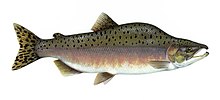Spawning hook

The spawning hook (called kype in English ) is a lower jaw shaped into a hook in some fish species. The spawn hook is an example of sexual dimorphism , a clear distinction between male and female animals. It comes with all sexually mature male fish from the family of salmon-like (salmonids) except for the Danube salmon before. As a secondary sexual characteristic, it grows shortly before the spawning season due to a hormonal change in fresh water and disappears again in some species after the spawning season. In addition to the spawning hook, the animals form a more or less pronounced hump between the head and the dorsal fin and turn a striking pink color.
The spawning hook is formed by an extension and curvature of the upper and lower jaw, with the lower jaw in particular growing and forming a hook-shaped extension. The teeth are replaced by new teeth that have no function; together with the deformation, food intake becomes impossible. Especially in species with strong deformations such as the pink salmon ( Oncorhynchus gorbuscha ) and the chum salmon ( Oncorhynchus keta ), these are irreversible; these animals die after the spawning season. Less severe deformations, such as those that occur in the Atlantic salmon ( Salmo salar ), disappear again after the spawning season.
literature
- Roland Gerstmeier, Thomas Romig: The freshwater fish of Europe . For nature lovers and anglers. In: Kosmos Naturführer , Kosmos, Stuttgart 1998, ISBN 3-440-07068-9 (2nd, revised and updated edition 2003, ISBN 978-3-440-09483-9 ).
